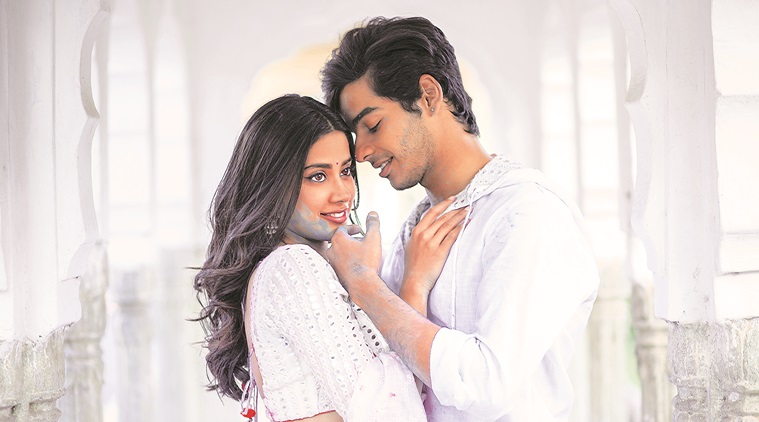
Societal issues have been the fabric of Indian cinema: Shashank Khaitan
Written by Ektaa Malik | Updated: July 17, 2..
Written by Ektaa Malik | Updated: July 17, 2018 12:46:00 am Shashank Khaitan with Janhvi Kapoor
Its been a fortnight of frantic promotions for the Dhadak team. The film, which releases this Friday, has newcomers and starkids Janhvi Kapoor and Ishaan Khatter in the lead. Its an adaptation of the hit 2016 Marathi film Sairat. We caught up with the director Shashank Khaitan as the team was wrapping up promotions in Kolkata, Khaitans home base. “I am a Calcutta Marwari, so yes this is familiar turf. But then our family moved to Nasik and I was raised there” says Khaitan, who has previously directed two back-to-back hits — Humpty Sharma Ki Dulhania (HSKD) and Badrinath Ki Dulhania (BKD).
Early in the conversation, the director clarifies that though Dhadak is an adaptation of Sairat, its language, setting, and treatment are vastly different. Sairat, directed by Nagraj Manjule, made quite a splash in Indian cinema, with its realistic take on caste and class. The lead actress Rinku Rajguru received the Special Jury Award at the 63rd National
Awards for her portrayal of Archie, an upper caste girl in love with low-caste boy. “ When I saw Sairat, I was inspired as a filmmaker. I wanted to share that story in my own language. But of course, I have kept to the essence of Sairat. Its a story that resonated with so many people,” says Khaitan. “Also, I felt, what Sairat communicated — it should be said reiterated and shared constantly.”
Ever since the trailer of Dhadak came out earlier in the year, the internet has been rife with memes about how it betrays the realism and the hard-hitting tone of the original. Added to the criticism are the exotic and beauteous locations of Udaipur, where it is set, along with the glamorous looks of the lead actors. “Comparisons are but natural.
 Dhadak stars newcomers Ishaan Khatter and Janhvi Kapoor
Dhadak stars newcomers Ishaan Khatter and Janhvi Kapoor
Even the criticism that has come along. The choice to set the film in Udaipur was a no-brainer. I have roots in Udaipur, I am very familiar with the social and geographical terrain. The actors are wearing what people in Udaipur wear and talk in the same lehjza. As for the beautiful locations, I cant make Udaipur look ugly. But the society there is as rooted as it is in Maharashtra,” says Khaitan.
Even an adaptation of Sairat, seems like a departure for Khaitan, whose previous two outings — HSKD & BKD — were as mainstream as it gets, replete with a Badshah rap. Added to this is the fact that all his films, including Dhadak, have been produced by Dharma Productions, helmed by Karan Johar. “Sairat dealt with caste, class, patriarchy, the socio-economic realities; it was a larger comment on society. While making Dhadak, I felt as if I am making my debut as a filmmaker all over again. One has to step out of ones comfort zone, or else one can stagnate.
We need to challenge ourselves and keep pushing our boundaries.” Independent and regional cinema in India has often dealt with issues of caste, class and patriarchy head on.
Manjules previous film, Fandry, dealt with a Dalit boy in love with an upper-caste girl. Mainstream Bollywood, has often shied away from such topics. Even romantic tragedies, like Qayamat se Qayamat Tak or the recent Goliyon Ki Raasleela Ram Leela were reduced to the fates of star-crossed lovers. Khaitan disagrees. “I think mainstream cinema has also dealt with societal issues and addressed them in a commercial way. 3 Idiots did it, and so did Dangal, Rang De Basanti. Even Badrinath Ki Dulhania addressed what women of today have to undergo. It might not have been done in the most in-your-face manner, but they do deliver a message — its been in the fabric of commercial Indian cinema. Thats the cinema I grew up on. They would be complete commercial potboilers, and yet drive home a point,” says Khaitan. “There are no set rules for filmmaking, grammar and treatment that dictate that a particular kind of film. Of course, in a commercial set up the pressures are more. Every filmmaker would want a wider audience for his/her work, nobody wants a film only to be seen by 30 people.”
There is also the question of casting newcomers in the film. “ I had seen Sairat with Varun Dhawan, we were in the same theatre. Even he was of the opinion that this film can only be remade with newcomers. One has to be fair to the story in the end.”
For all the latest Entertainment News, download Indian Express App
- Tags:
- Dhadak

